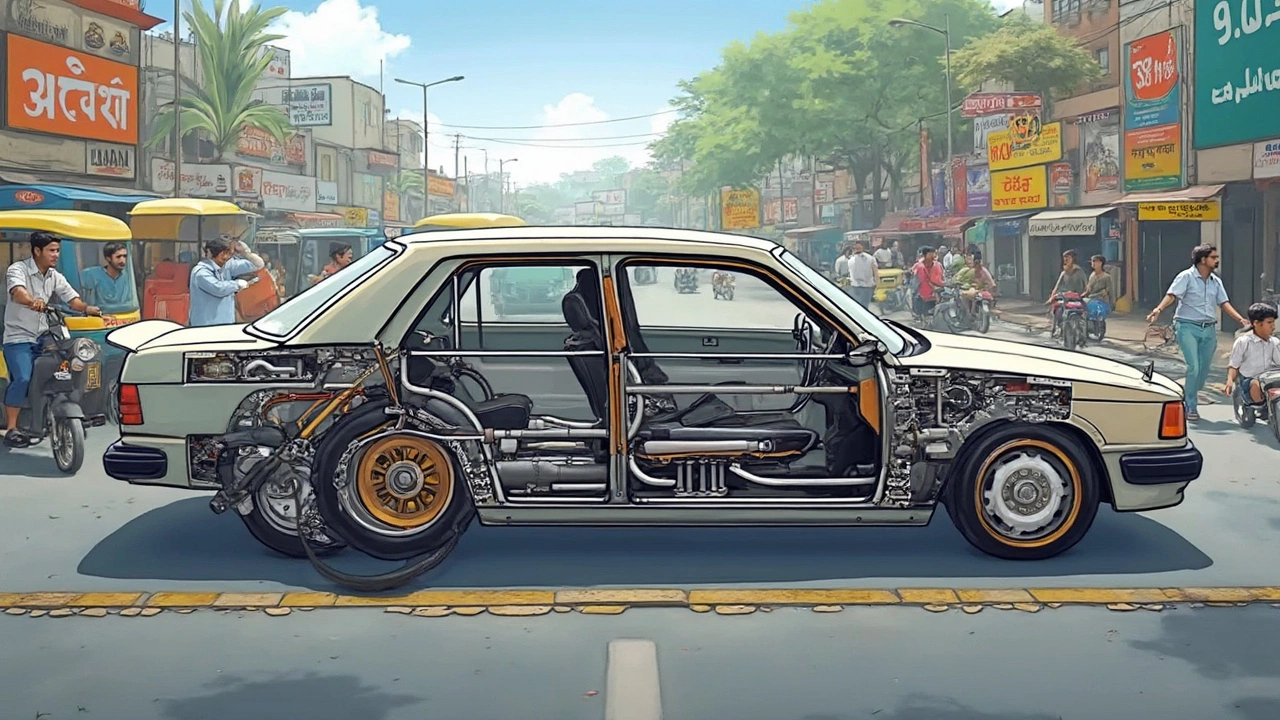Are Lowering Springs Worth It? An Honest Look
 Mar, 22 2025
Mar, 22 2025
So, you're toying with the idea of adding lowering springs to your car? You're not alone; it's a common upgrade for folks looking to beef up performance or simply improve the aesthetic appeal of their vehicles. But, before you dive in, let's break down what you need to know.
Lowering springs are designed to replace your car’s stock spring system, effectively reducing the distance between the vehicle body and the ground. This lowers the car's center of gravity, which can enhance handling and give a sportier look. But, while all that sounds sweet, are they really worth it?
It's not just about looks and better cornering. You have to consider changes in ride comfort, potential wear on other suspension components, and impact on your vehicle's practicality, like ground clearance. Keep in mind, it's about finding that sweet spot between performance and comfort, depending on your specific needs and what you primarily use your car for.
- Understanding Lowering Springs
- Performance and Handling Benefits
- Ride Quality and Comfort: What Changes?
- Potential Downsides You Should Know
- Tips for Choosing the Right Springs
Understanding Lowering Springs
Alright, first things first. What exactly are lowering springs? They're essentially coils that replace your car's original spring system to drop the ride height. This tweak isn't just for show-offs—it's about improving your car's grip on the road. Lowering the car's center of gravity can lead to tighter handling in the corners. Sounds neat, right?
But let's dig deeper. When you opt for lowering springs, you're not just dropping the car's height aimlessly. They're specifically engineered to support the weight of your car while providing a certain level of rigidity. Here's what that translates to in the real world: less body roll, improved aerodynamics, and—in some cases—a reduction in wind resistance.
Types of Lowering Springs
You've got a couple of options if you're considering this modification. There's the progressive spring, which provides a softer ride at first and stiffens as the spring compresses. This is perfect for driving daily but still wanting that occasional sporty feel. Then there are linear springs, which maintain a consistent stiffness throughout compression, ideal for pure performance-driven enthusiasts.
How Much Can You Lower?
Typically, you can expect to drop the car by about 1 to 2 inches with most lowering springs. Any more than that, and you might encounter issues like scraping speed bumps or driveways. Plus, the more you lower, the more you'll need to factor in alignment adjustments. Speaking of which, ensuring the right suspension geometry after dropping your car is crucial for safety and performance.
Check out this quick overview on typical drop heights for various car types:
| Car Type | Typical Drop (inches) |
|---|---|
| Sedan | 1.5-2.0 |
| Sports Coupe | 1.0-1.5 |
| SUV/Crossover | 1.0-1.5 |
Before you grab a set, consider what you want out of those springs. Street racing? Daily driving? Or maybe just looking slick at the next car meet? The right pick will make sure you don't sacrifice too much comfort for performance gains.
Performance and Handling Benefits
If you're considering lowering springs, chances are you're eyeing that sweet boost in performance they promise. One of the big draws is how they can tighten up your car’s handling. A lower center of gravity means your vehicle is hugging the road like a pro, which comes especially handy in those tight corners.
Here's a fun fact: Most cars are designed with a bit of extra clearance to accommodate a range of conditions and drivers who might not prioritize performance. By switching to lowering springs, you're taking things into your own hands, dialing in to the racer’s feel. Just imagine less roll in curves and more stability at speed—sounds like a dream, right?
Improved Aerodynamics
Lowering your car can also enhance its aerodynamics. With the car closer to the ground, it reduces air drag, which might give you a slight edge in fuel efficiency on the highway—not to mention adding to the sporty vibe.
Enhanced Steering Feedback
Another perk? You’ll likely notice improved steering feedback. That’s because lowering springs can make the steering heavier and more direct, giving you a more precise connection with the road.
“Lowering a car effectively reduces the center of gravity, providing better stability and control. It transforms the driving experience—which is why it’s popular among performance enthusiasts.” – Car Tuning Weekly
The Design Advantage
Though looks aren’t everything, we can’t skip the fact that lowering springs often give cars that aggressive stance that turns heads. It’s a package deal of form meeting function.
Considerations
While there are undeniable performance ups from suspension upgrades, keep in mind it isn’t just about immediate improvements; you should weigh potential impacts on tire wear and suspension integrity over time. If performance is your top priority, it’s crucial to balance these benefits with practical considerations.

Ride Quality and Comfort: What Changes?
When you're considering lowering springs for your ride, it’s crucial to think about how these might impact your day-to-day comfort. Yeah, they look cool and can boost handling, but what happens when you're just trying to have a smooth drive?
Feeling Every Bump
One of the most noticeable differences when you install lowering springs is that you’ll start to feel the road more. This isn’t necessarily a bad thing if you’re after that sporty drive feel. But know that every pothole and pesky speed bump will be more pronounced. If your daily drive involves a lot of rough roads, it could get annoying.
Impact on Long Drives
Ever been on a long drive where the road just seems endless? If your car is fitted with lowering springs, those long drives can feel different. The firmer suspension setup usually means you’re getting feedback from the road, which can be tiring if you're not used to it. It’s a trade-off between feeling connected to the road and wanting that cushy, plush ride.
Practical Concerns
Lowering springs can mess with your car's ability to handle big bumps and steep driveways. You might find yourself dodging these to avoid scraping your undercarriage. So, if you have an aggressively lowered ride, watch out for things like speed bumps and curbs.
| Consideration | Effect |
|---|---|
| Pothole Sensitivity | Increased |
| Long Drive Comfort | Moderate to Low |
| Urban Driving | Requires caution |
Ultimately, whether lowering springs improve your drive depends on what you value. If a sporty feel and better cornering are top of your list, you might love them. But if smooth rides are your jam, you might want to think twice.
Potential Downsides You Should Know
Alright, so we've talked about the cool stuff, but what about the not-so-glamorous side of lowering springs? Every rose has its thorn, and lowering your car isn’t any different. Here’s what you should keep in mind before making the jump.
Comfort versus Performance
First off, altering your suspension is gonna change your ride comfort. While your car might hug the road better, it could lead to a stiffer ride. Those bumps and potholes might feel more intense because your suspension travel is reduced. You have to decide if that trade-off is worth it for the improved cornering and handling.
Potential for Increased Wear
Another thing to ponder is how lowering springs might increase wear on other components. With a lowered vehicle, parts like shocks, struts, and even your tires could wear out quicker because they're dealing with more stress. This could mean more frequent maintenance or replacements, which can add up in cost.
Ground Clearance Issues
Don't forget about ground clearance. A lower car looks sharp, but it can be a headache on steep driveways or speed bumps. You might find yourself navigating daily routes more carefully, or even avoiding certain roads altogether. Is sacrificing practical driving for style or performance worth it? That's up to you.
Insurance Considerations
Also, your insurance might be affected. Some insurance companies see car modifications as a gamble, and your rates could increase. It’s wise to check in with your insurer before making any changes to avoid any surprise expenses later.
Stability on Uneven Roads
Lastly, while suspension upgrade helps with handling on smooth roads, it can make your vehicle feel unstable on uneven surfaces. The altered suspension geometry can affect handling dynamics in unexpected ways, especially on rough terrain.
Overall, it's crucial to weigh the pros and cons to decide if lowering springs align with your driving lifestyle. Always ask, "Are lowering springs worth it for my situation?"

Tips for Choosing the Right Springs
Looking to enhance your ride with lowering springs? Here are some handy tips to help you make the best choice without losing sleep over it. This is no small investment, and making the right choice can save you from future headaches.
1. Consider Your Driving Habits
First things first, think about how and where you usually drive. Are you cruising the city streets or hitting the track on weekends? City drivers might prefer springs that offer a balance between performance and comfort, while track enthusiasts can opt for stiffer setups that boost handling.
2. Brand Matters
Let’s not kid ourselves—a well-known brand can make a difference. Look for brands with a solid reputation in the automotive world. Though they might cost a bit more, you're paying for quality, performance, and, most times, better customer support.
3. Compatibility and Installation
Not all lowering springs are one-size-fits-all. Make sure the springs you pick are compatible with your car model. It is also wise to consider the installation process. Some springs require more intensive changes to other parts of the suspension system. Do you need a professional to install them?
4. Know the Drop
The amount of drop provided by the springs is crucial. A dramatic drop can look cool, but if it's too low, you might end up bottoming out on the smallest of bumps. Typically, a 1-2 inch drop is manageable for most daily drivers.
5. Budget Wisely
Price is always a factor, right? But more expensive doesn’t always mean better. Make sure you’re getting the best value for your budget. Sometimes middle-of-the-road options strike a great balance between cost and performance.
| Spring Brand | Average Cost |
|---|---|
| Eibach | $250 - $350 |
| H&R | $200 - $300 |
| B&G Suspension | $150 - $250 |
| Tein | $300 - $400 |
Finally, don’t hesitate to seek advice from forums or groups specific to your car make and model. Experienced users can offer insights that are not often found in product descriptions. Remember, the right set of lowering springs should enhance your driving experience, not complicate it.